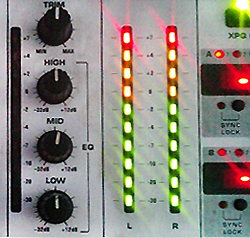Maintaining proper levels throughout your signal chain is important for achieving great tone. This is an important discussion for guitarists and engineers. I think pretty hard about my gain staging when I’m tracking. It has great affect on your sound.
But, why and how does gain affect sound? Let’s investigate.
1. Digital Wall
There are many reasons to love the analog medium.
One, so old guys can sit around the coffee machine and reflect on the golden days of recording (yawn).
The second? Analog takes change well. It’s forgiving. That means if you hit it with a hot signal, it’s not going to sound horrible. Disclaimer: that’s not guaranteed. I mean, fire is great, but if you leave something on the stove too long it burns, right? Not that I would know as my form of cooking is local delivery here in NYC. But, I do read things.
Analog distortion is considered flattering by many, including myself. Digital clipping is harsh and rarely desirable. Although, I got a cool snare drum sound once by clipping digital converters. (To which my mixer asked “why ya’ gotta like be such a rebel all the time”). I think he may have been afraid I would fray the fragile woven fabric that is our conscious being. Whoa, deep right?
When running digital gear, you have to be very aware of the signals running before it. If your signal is too hot before a digital reverb or delay, it’s going to clip in a harsh way.
Digital clipping can sneak up on you too. I’ve had experiences where I didn’t really notice it. I took for granted my gain staging was good.
2. Analog Barbells
Hot analog signals can be swell. Those that have spent time messing with tubes have discovered the joy in hitting tubes with a little gain.
A secret trick of guitarists is to use a preamp before their guitar amp. It’s usually the last piece in the chain. A popular choice is the preamp from an Echoplex.
What does it sound like? It livens up the sound. I always make sure the preamp is pushing a few dB hotter then when it’s in bypass. The idea here is that you leave it on all the time.
Nowadays everyone is in on the secret. There are pedal manufactures that make boosters or Echoplex preamps in small boxes. I use a Fulltone Tube Tape Echo for this trick with the delay off.
It kisses the front end of my tweeds nicely. We’re not talking a porn kiss here, but a romantic long embrace. Ah, who am I kidding… They’re getting it on.





















